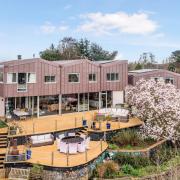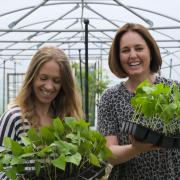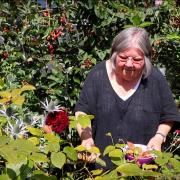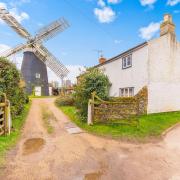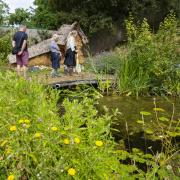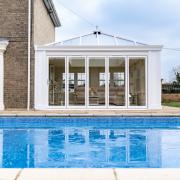What’s going on at Somerleyton Hall? Many of us will recall a visit to one of England’s finest stately homes on a family day out. We marvelled at majestic trees and stared fearfully at stuffed polar bears in the entrance hall before getting hopelessly lost in the famous yew maze.
Years later, it was vast borders of perennials and the sheer spectacle of this extravagant Victorian mansion, with its ornate statuary, that had us smitten. Tea in the orangery was (literally) the icing on the cake. What happened to all that?

Well, thankfully, nothing stays exactly the same. How could it? Hugh Crossley, son of third baron Savile Crossley, is the current Lord Somerleyton. He and wife Lara have three young children, reason in itself to focus on what they call 'restoring equilibrium', and 'giving back to nature' on the whole estate, Fritton Lake included.
The magnificent house and garden has its beginnings way back in the 17th century, and Lord Somerleyton has embarked on a garden restoration programme, with celebrated designers such as George Carter and Xa Tollemache, that fully recognises and represents past glories, as well as fulfilling the family’s own aspirations on biodiversity.

Enter Simon Gaches, head of gardens at Somerleyton since 2019 and formerly head gardener at the Bishop’s Palace in Norwich, where his 25-year record so impressed Lord and Lady Somerleyton that they have entrusted him with the task of bringing the gardens back to being among the top five to visit in East Anglia.
'That was my goal and brief, so not only is it an historic garden where you have the heritage and the amazing buildings and glasshouses, but also to make it botanically interesting – bringing in more trees, more shrubs and more flowers.'
Where to start in a vast 12-acre garden? That might be the first and most obvious question but Simon and his team have already made impressive headway, notably in the rose garden, kitchen garden and an exciting new jungle garden with a children’s play area. So let’s start at the entrance, where you can pick up a map – because you'll need one in this, the grandest estate in east Suffolk. Let’s imagine you’re keen to plunge straight in, for the moment passing the entrance to the jungle garden and play area.
An immediate sensation is the famous herbaceous border, re-planted by Xa Tollemache in 2013 to mark the 150th anniversary of the Crossleys at Somerleyton. You could be forgiven for not realising this mass of colourful perennials is actually part of an historic walled garden, but that is changing thanks to Simon’s part in the 're-imagining' with new borders and pathways.

Look left and there’s a splendid border of healthy exotics with different forms of Tetrapanax papyrifer, the rice paper plant, a giant Miscanthus, and the handsome evergreen Euphorbia × pasteurii 'John Phillips'. Look right, there’s more exotics and a dedicated hosta border. 'We’ve over 200 types now,' says Simon. And there are tree ferns to come. Opposite is a sunny area destined for peonies, delphiniums, hyacinths and lilies. Simon is relaxed about mixing shapes and colours.
'I don’t tend to go for any colour spectrum; I just bung any colour in and I think that works. Why follow a book? Just plant what you like.' And onwards! We’re headed to the kitchen garden past the exceptional Joseph Paxton glasshouses, including the peach cases that long-time visitors to the garden will recall. Still within the walled garden, we’re entering the kitchen and cutting garden, once closed to the public, now, thank goodness, open to all, which means it has to look good as well as providing healthy produce and cut flowers for the hall, the shop and Fritton Lake.
'We’ve added new central beds and a herb garden with a fruit cage on the way soon. All the turf we lifted from the shrub borders we used to create island beds for cut flowers - over 60 on either side,' says Simon. And yes, it’s certainly looking good with beds of dazzling alstromeria having followed spring tulips, and flamboyant dahlias to enjoy later in the season. Meanwhile there’s plenty of cutting and snipping to be done, contributing to an astounding seven miles of lawn edging in the entire hall garden.
The garden is a successful mix of formality with areas of rewilding, echoing Hugh Crossley’s WildEast, back-to-nature ambitions for the whole estate. 'We’re aiming for 20 per cent of the garden being left to nature,' Simon explains. 'The lawns are not cut when the clover is out, which bees love. And we’ve got three large areas in the arboretum which we manage by cutting footpaths through.' He also mentions the 200,000 bulbs planted so far, so look out for a sensational spring show.

It’s all a wonderful contrast to the formal areas outside the walled garden, including the famous yew hedge, (involving three weeks of cutting in late summer), and the parterre of the west façade of the hall by renowned Victorian landscaper William Nesfield. You can still stroll through the famous wrought iron pergola with wisteria up to 150 years old and admire the Sunken White Garden for weddings, a theme chosen by Lady Somerleyton. Naturally, she also had a hand in My Lady’s Garden, restored in 2019 and now resplendent with pink and white roses wafting out their heady perfume to the delight of visitors.
'We did two years of planting these beds,' Simon explains. 'The ones with the obelisks, added this spring, are ‘Ballerina’ and ‘The Fairy’. There are over 1,000 roses here now.' There’s not space here to describe all the spectacular features of this garden, not least the magnificent mature trees in the arboretum, county champions among them. But you may be wondering how Simon came to take on a project that some might regard as daunting, if not formidable.

It was his father, a consultant surgeon, who passed on his love of gardening to his son; Simon would help out at weekends for pocket money. Gaining an HND in hotel management, he dropped out of his chosen career when it didn’t match up to what he had learned. This eventually led to a one-year, intensive horticultural course at Easton College, Norfolk. That’s when the job of head gardener at the Bishop’s Garden came up, a post he held for the next 25 years, to much acclaim for his transformative planting and helping to raise £300,000 for charity.
Bishop Graham, the current Bishop’s predecessor, married Hugh Crossley and Lara, now Lady Somerleyton, in 2010; when they visited the Bishop’s Garden that same year, Simon introduced himself. That eventually led to his starting work at Somerleyton part-time for a year while he completed work he had started at the Bishop’s Garden. In 2019, he became full-time head of gardens at Somerleyton, just six months before Covid lockdown.
'We had only one and a half volunteers during two years of lockdown and no income, so it was an uphill battle,' says Simon. It meant a five-year plan may be extended to seven, as it can take three to five years for new plants to bed in, grow and mature. Now Simon has a team of three paid staff, Jonathan, Jo and Sam, all there before him, and 12 volunteers, of whom he is rightly proud. Each person takes ownership of what they do, giving them more satisfaction.

We can’t leave this remarkable garden without a visit to Simon’s Jungle Garden and play area. But where is it exactly? Children especially might note that it’s just after the entrance to the garden on your right, but you would hardly know it’s there, which is the whole idea. Stepping in, you’re immediately struck by the exotic planting and bold stands of bamboo. Do they run? 'Yes, we keep an eye out, but it’s a jungle after all,' says Simon. Here’s more Tetrapanax papyrifer, and Miscanthus lutarioriparius which can grow six metres in height.
'And we have bananas and about 30 different gingers.' He’s clearly in his element among all these rarities. 'As the gingers come into flower, everything becomes much larger in here,' he says enthusiastically. 'Here’s the giant hosta ‘Empress Wu’. We’ll add more clump-forming bamboos and a couple more palms so we’ve got that structure, and then more bananas, more foliage plants so you will be basically walking under banana leaves to create more of an enclosure.' Exciting! Finding your way through the jungle, you then reach the play area with swings and a large sandpit and a climbing structure to come. It’s a bit of magic that adults and children enjoy.

The next large-scale project is by the aviary, to create a woodland walk, a winter garden walk and a new pond development with ferns. 'The thing that makes this place so nice is that it’s still in private ownership,' says Simon. 'You haven’t got that corporate feel and you haven’t got signs left right and centre which makes it feel very relaxed.' Through the Greenhouse café there’s a plant sales area for those keen to take a memento of a special day out.
'We’ve set up a plant nursery and this is set to be a promising enterprise,' says Simon. 'Our main philosophy on the plant sales is that everything you see is what’s growing in the garden.' Somerleyton Hall is surely already one of the best places to visit in East Anglia.










